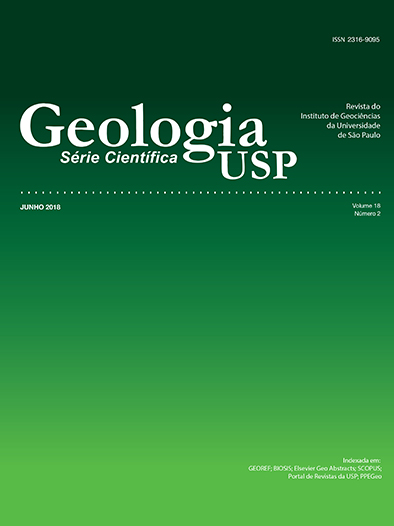Ground Penetrating Radar digital imaging and modeling of microbialites from the Salitre Formation, Northeast Brazil
DOI:
https://doi.org/10.11606/issn.2316-9095.v18-146075Keywords:
Ground Penetrating Radar, Microbialites, Geophysical attributes.Abstract
Thanks to the discovery of new giant oil fields in the South Hemisphere in the last decades, named Pre-salt, there has been a considerable interest in the geometrical and sedimentological characterization of microbial deposits, coquinas, and collapsed caves, which represent a considerable part of these reservoirs. It is known that exposures analogous to oil reservoirs are an important source of information at the sub-seismic scale, as this information is helpful in parametrizing and modeling reservoirs, especially microbial reservoirs. This scenario is more favorable when the Ground Penetrating Radar (GPR) method is used in analogous exposures located in arid regions with scarce or no soil, such as the Fazenda Arrecife, in the Chapada Diamantina (Salitre Formation), Northeastern Brazil. Although rarely mentioned in the literature on microbialite geophysical imaging, GPR has been used in microbial deposits associated with the Neoproterozoic storm deposits of the Salitre Formation. The results of 3D imaging of a microbial colony, using the 200 MHz antenna, with both conventional processing and processing using geophysical attributes, are presented in this study. The conventional processing produced a 3D digital model that allowed the geometrical characterization and parametrization of the imaged microbial colony. The use of four geophysical attributes yielded good results, establishing the contact between the microbial colony and tempestite deposits, and determining the internal geometry of microbial deposits. The processing with “instantaneous amplitude” and “Hilbert trace with energy” highlighted the contact between the microbialite colony (low amplitude) and tempestite deposits (high amplitude), whereas the processing with the “energy” attribute provided a better visualization of the internal lamination of columnar microbialites, result similar to that obtained in the processing with “Hilbert trace with similarity”. GPR obtained images of up to 10 m in depth, with excellent resolution for microbial deposits and tempestites associated with them. The processing using geophysical attributes achieved considerably better results when compared to conventional processing, allowing a better visualization of the internal and external geometry of the imaged colony.
Downloads
Published
Issue
Section
License
Authors who publish in this journal shall comply with the following terms:
- Authors keep their copyright and grant to Geologia USP: Série Científica the right of first publication, with the paper under the Creative Commons BY-NC-SA license (summary of the license: https://creativecommons.org/licenses/by-nc-sa/4.0 | full text of the license: https://creativecommons.org/licenses/by-nc-sa/4.0/legalcode) that allows the non-commercial sharing of the paper and granting the proper copyrights of the first publication in this journal.
- Authors are authorized to take additional contracts separately, for non-exclusive distribution of the version of the paper published in this journal (publish in institutional repository or as a book chapter), granting the proper copyrights of first publication in this journal.
- Authors are allowed and encouraged to publish and distribute their paper online (in institutional repositories or their personal page) at any point before or during the editorial process, since this can generate productive changes as well as increase the impact and citation of the published paper (See The effect of Open Access and downloads on citation impact).





